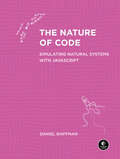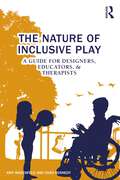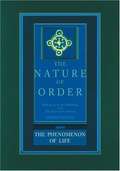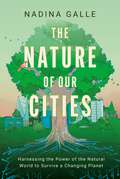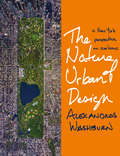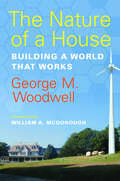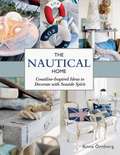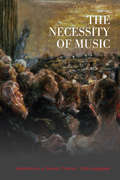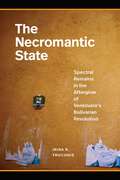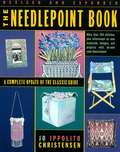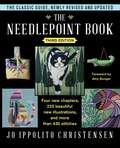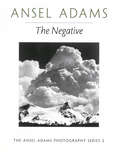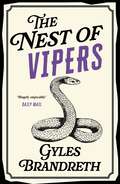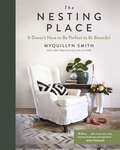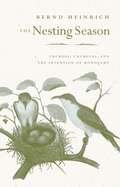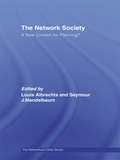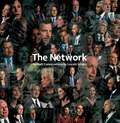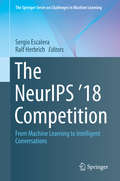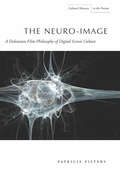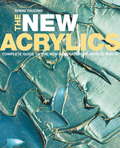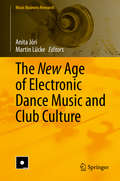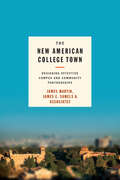- Table View
- List View
The Nature of Code: Simulating Natural Systems with JavaScript
by Daniel ShiffmanAll aboard The Coding Train! This beginner-friendly creative coding tutorial is designed to grow your skills in a fun, hands-on way as you build simulations of real-world phenomena with &“The Coding Train&” YouTube star Daniel Shiffman.What if you could re-create the awe-inspiring flocking patterns of birds or the hypnotic dance of fireflies—with code? For over a decade, The Nature of Code has empowered countless readers to do just that, bridging the gap between creative expression and programming. This innovative guide by Daniel Shiffman, creator of the beloved Coding Train, welcomes budding and seasoned programmers alike into a world where code meets playful creativity.This JavaScript-based edition of Shiffman&’s groundbreaking work gently unfolds the mysteries of the natural world, turning complex topics like genetic algorithms, physics-based simulations, and neural networks into accessible and visually stunning creations.Embark on this extraordinary adventure with projects involving:A physics engine: Simulate the push and pull of gravitational attraction.Flocking birds: Choreograph the mesmerizing dance of a flock.Branching trees: Grow lifelike and organic tree structures.Neural networks: Craft intelligent systems that learn and adapt.Cellular automata: Uncover the magic of self-organizing patterns.Evolutionary algorithms: Play witness to natural selection in your code.Shiffman&’s work has transformed thousands of curious minds into creators, breaking down barriers between science, art, and technology, and inviting readers to see code not just as a tool for tasks but as a canvas for boundless creativity.Whether you&’re deciphering the elegant patterns of natural phenomena or crafting your own digital ecosystems, Shiffman&’s guidance is sure to inform and inspire. The Nature of Code is not just about coding; it&’s about looking at the natural world in a new way and letting its wonders inspire your next creation. Dive in and discover the joy of turning code into art—all while mastering coding fundamentals along the way.NOTE: All examples are written with p5.js, a JavaScript library for creative coding, and are available on the book's website.
The Nature of Inclusive Play: A Guide for Designers, Educators, and Therapists
by Amy Wagenfeld Chad KennedyThis book provides designers, planners, educators, and therapists with the practical information required to remove inequity in outdoor spaces, by creating inviting and inclusive solutions so that all children and their families, regardless of situation or circumstance, can experience the joys and benefits of outdoor play without stigma. It is the first of its kind, co-written by an occupational therapist and landscape architect both with proven expertise in inclusive play space design. The Nature of Inclusive Play fills an untapped niche in promoting the value of outdoor play. It focuses on what embodies play and shows how, through inclusive outdoor play design, developmental skills can be enriched. The topics covered in the book include: • a discussion of the health benefits associated with being outdoors • the history of and value of play • an overview of typical child development • the importance of sensory regulation • an inclusive design review process • design guidelines. All topics are supplemented with nine applicable case studies of inclusive outdoor play spaces with features that reflect inclusive+ principles, including examples from North America and Africa. It is a much-needed guide for landscape architects, urban planners, allied health care professionals, early childhood educators, academics, and students.
The Nature of Order, An Essay on the Art of Building and the Nature of the Universe: Volume 1, The Phenomenon of Life
by Christopher AlexanderWhat is happening when a place in the world has life? And what is happening when it does not? In Book 1 of this four-volume work, Alexander describes a scientific view of the world in which all space-matter has perceptible degrees of life, and sets this understanding of living structure as an intellectual basis for a new architecture. He identifies fifteen geometric properties which tend to accompany the presence of life in nature, and also in the buildings and cities we make. These properties are seen over and over in nature, and in cities and streets of the past, but have all but disappeared in the deadly developments and buildings of the last one hundred years. The book shows that living structure depends on features which make a close connection with the human self, and that only living structure has the capacity to support human well-being. The other three volumes of The Nature of Order continue this thesis with three complementary views giving a masterful prescription for the processes which allow us to generate living structure in the world. They show us what such a world must gradually come to look like, and describe the modified cosmology in which "life" as an essential quality, together with our inner connection to the world around us-towns, streets, buildings, and artifacts-are central to a proper understanding of the scientific nature of the universe. "... Five hundred years is a long time, and I don't expect many of the people I interview will be known in the year 2500. Christopher Alexander may be an exception."--David Creelman, author, interviewer and editor, HR Magazine, Toronto. Christopher Alexander is a fellow of the American Academy of Arts and Sciences, architect, builder and author of many books and technical papers. He is the winner of the first medal for research ever awarded by the American Institute of Architects, and after 40 years of teaching is Professor Emeritus at the University of California, Berkeley.
The Nature of Our Cities: Harnessing the Power of the Natural World to Survive a Changing Planet
by Nadina GalleIn the tradition of Elizabeth Kolbert and Michael Pollan, The Nature of Our Cities is a stirring exploration of how innovators from around the world are combining urban nature with emerging technologies, protecting the planet’s cities from the effects of climate change and safeguarding the health of their inhabitants.We live in an age when humanity spends 90% of its time indoors, yet the nature around us—especially in America’s cities—has never been more vital. This distancing from nature has sparked crises in mental health, longevity, and hope for the next generation, while also heightening the risks we face from historic floods, heatwaves, and wildfires. Indeed, embracing nature holds untapped potential to strengthen and fortify our cities, suburbs, and towns, providing solutions spanning flood preparation, wildfire management, and promoting longevity. As ecological engineer Dr. Nadina Galle shows in The Nature of Our Cities nature is our most critical infrastructure for tackling the climate crisis. It just needs a little help. A fellow at MIT’s Senseable City Lab and selected for Forbes’ 30 under 30 list, Galle is at the forefront of the growing movement to fuse nature and technology for urban resilience. In THE NATURE OF OUR CITIES, she embarks on a journey as fascinating as it is pressing, showing how scientists and citizens from around the world are harnessing emerging technologies to unlock the power of the natural world to save their cities, a phenomenon she calls the “Internet of Nature.” Traveling the globe, Galle examines how urban nature, long an afterthought for many, actually points the way toward a more sustainable future. She reveals how technology can help nature navigate this precarious moment with modern advances such as:Laser-mapping that identifies at-risk neighborhoods to fight deadly health disparitiesA.I.-powered robots that prevent wildfires from reaching urban areasIntelligent water gardens that protect cities from floods and hurricanesAdvanced sensors that achieve 99% tree survival in dry, hot summers Optimistic in spirit yet pragmatic in approach, Galle writes persuasively that the future of urban life depends on balancing the natural world with the technology that can help sustain it. By turns clear-eyed and lyrical, THE NATURE OF OUR CITIES marks the emergence of an invigorating, prescient new talent in nature writing.
The Nature of Urban Design: A New York Perspective on Resilience
by Alexandros WashburnThe best cities become an ingrained part of their residents' identities. Urban design is the key to this process, but all too often, citizens abandon it to professionals, unable to see a way to express what they love and value in their own neighborhoods. New in paperback, this visually rich book by Alexandros Washburn, former Chief Urban Designer of the New York Department of City Planning, redefines urban design. His book empowers urbanites and lays the foundations for a new approach to design that will help cities to prosper in an uncertain future. He asks his readers to consider how cities shape communities, for it is the strength of our communities, he argues, that will determine how we respond to crises like Hurricane Sandy, whose floodwaters he watched from his home in Red Hook, Brooklyn. Washburn draws heavily on his experience within the New York City planning system while highlighting forward-thinking developments in cities around the world. He grounds his book in the realities of political and financial challenges that hasten or hinder even the most beautiful designs. By discussing projects like the High Line and the Harlem Children's Zone as well as examples from Seoul to Singapore, he explores the nuances of the urban design process while emphasizing the importance of individuals with the drive to make a difference in their city. Throughout the book, Washburn shows how a well-designed city can be the most efficient, equitable, safe, and enriching place on earth. The Nature of Urban Design provides a framework for participating in the process of change and will inspire and inform anyone who cares about cities.
The Nature of a House: Building a World that Works
by George M. WoodwellIs it possible for a group of the world's most respected environmental scientists to truly practice what they preach? Can their expertise in climate change help them in transforming an old house and its nine acres into their new office building and campus--a building that is as energy efficient as possible, uses local materials, and generates all of the energy it consumes? In this candid, charming, and informative book, the director of the renowned Woods Hole Research Center tells a story that will interest anyone who has ever thought about doing a "green" rehab, has tried to build green, or just wonders what's actually possible. The Woods Hole Research Center is an international leader in identifying the causes and consequences of environmental change. When the WHRC needed a new administration building, its scientists and staff decided that the building should utilize "state-of-the-shelf" green building techniques and materials. However, the new office had to conform with the laws and building codes of the time, and with materials that were then available--no matter how frustrating these requirements were to the resident scientists and contractors. The author, George M. Woodwell, founder of the WHRC, was intimately involved in the design and construction of the Gilman Ordway Campus, which was completed in 2003. He details the challenges they faced, but also puts the building in a larger context, not only within the work of the Center and the tradition of Woods Hole, but in the global need to minimize our carbon emissions and overall environmental impact. Building a world that works requires rethinking how we design, reuse, and live in the built environment while preserving the functional integrity of the landscape.
The Nautical Home: Coastline-Inspired Ideas to Decorate with Seaside Spirit
by Anna OrnbergAre you a beach bum, a beach lover, or simply just a fan of the water? If you find yourself constantly longing for a relaxing vacation along the sandy shores of Tahiti or yearning to go on a coast-to-coast cruise, look no further. Interior designer Anna Örnberg has all the solutions to bring the waves to your home and living room. With Anna’s advice and expertise, you can turn your own apartment or living space into a beautiful waterfront home. Live on the beach with nautical style and enjoy the waves. Using seashells, ropes, dark woods, and light-colored walls, the interior designs in this book remind readers of sunken ships and buried treasures. The decor will inspire homeowners to personalize their homes into the most calming and soothing living quarters, a place where they can sit, relax, and enjoy the ocean breeze. Projects include: Wooden lampshades Nautical placemats and pot holders Building your own lighthouse Beanbags and pillowcases The nautical look is a classic theme that suits a wide audience. Whether you’re looking for new ideas to spruce up your city center apartment or looking to decorate your holiday vacation home, this book has the answers. The Nautical Home has a little something for everyone, from the average homeowner hoping to reinvent a room or more to the recent college grad looking for new ways to decorate a new home. With the interior designs in this book, you can finally be the captain of your own ship or home.
The Nazi Perpetrator: Postwar German Art and the Politics of the Right
by Paul B. JaskotWho was responsible for the crimes of the Nazis? Party leaders and members? Rank-and-file soldiers and bureaucrats? Ordinary Germans? This question looms over German disputes about the past like few others. It also looms over the art and architecture of postwar Germany in ways that have been surprisingly neglected. In The Nazi Perpetrator, Paul B. Jaskot fundamentally reevaluates pivotal developments in postwar German art and architecture against the backdrop of contentious contemporary debates over the Nazi past and the difficulty of determining who was or was not a Nazi perpetrator.Like their fellow Germans, postwar artists and architects grappled with the Nazi past and the problem of defining the Nazi perpetrator—a problem that was thoroughly entangled with contemporary conservative politics and the explosive issue of former Nazis living in postwar Germany. Beginning with the formative connection between Nazi politics and art during the 1930s, The Nazi Perpetrator traces the dilemma of identifying the perpetrator across the entire postwar period. Jaskot examines key works and episodes from West Germany and, after 1989, reunified Germany, showing how the changing perception of the perpetrator deeply impacted art and architecture, even in cases where artworks and buildings seem to have no obvious relation to the Nazi past. The book also reinterprets important periods in the careers of such major figures as Gerhard Richter, Anselm Kiefer, and Daniel Libeskind.Combining political history with a close analysis of specific works, The Nazi Perpetrator powerfully demonstrates that the ongoing influence of Nazi Germany after 1945 is much more central to understanding a wide range of modern German art and architecture than cultural historians have previously recognized.
The Necessity of Art: A Marxist Approach
by Ernst Fischer Anna BostockThe author, an Austrian poet and critic, surveys the whole history of artistic achievement through Marxist eyes.
The Necessity of Music: Variations on a German Theme
by Celia ApplegateIn The Necessity of Music, Celia Applegate explores the many ways that Germans thought about and made music from the eighteenth- to twentieth-centuries. Rather than focus on familiar stories of composers and their work Applegate illuminates the myriad ways in which music is integral to German social life. Musical life reflected the polycentric nature of German social and political life, even while it provided many opportunities to experience what was common among Germans. Musical activities also allowed Germans, whether professional musicians, dedicated amateurs, or simply listeners, to participate in European culture. Applegate’s original and fascinating analysis of Mendelssohn, Schumann, Brahms, Wagner, and military music enables the reader to understand music through the experiences of listeners, performers, and institutions. The Necessity of Music demonstrates that playing, experiencing, and interpreting music was a powerful factor that shaped German collective life.
The Necromantic State: Spectral Remains in the Afterglow of Venezuela's Bolivarian Revolution
by Irina R TroconisIn the spring of 2013, televisions across Venezuela announced the death of then-president Hugo Chávez, leader of the Bolivarian Revolution and key political actor in Latin America’s “turn to the left.” Chávez’s death, however, was not the end of Chávez’s life. In The Necromantic State, Irina R. Troconis examines how Chávez, as a “specter,” has lingered in Venezuela’s public, private, and digital spaces. Focusing on contemporary Venezuela and drawing from a diverse corpus that includes tattoos, toys, memes, graffiti, and a hologram haunting the streets of downtown Caracas, Troconis contends that, in moments of failed transitions, political tensions, and crises of legitimacy, the state brings the dead back to life to negotiate the terms of its survival. By showing how this necromantic performance enables the state’s material and visual manifestations in public and private spaces, Troconis untangles a sociopolitical moment in which the ghostly acts as the affective, social, and political force that grounds state authority and ensures the preservation of the status quo, as it circumscribes acts of political imagination and limits popular resistance.
The Needle and the Lens: Pop Goes to the Movies from Rock 'n' Roll to Synthwave
by Nate PatrinHow the creative use of pop music in film—think Saturday Night Fever or Apocalypse Now—has shaped and shifted music history since the 1960s Quick: What movie do you think of when you hear &“The Sounds of Silence&”? Better yet, what song comes to mind when you think of The Graduate? The link between film and song endures as more than a memory, Nate Patrin suggests with this wide-ranging and energetic book. It is, in fact, a sort of cultural symbiosis that has mutually influenced movies and pop music, a phenomenon Patrin tracks through the past fifty years, revealing the power of music in movies to move the needle in popular culture. Rock &’n&’ roll, reggae, R&B, jazz, techno, and hip-hop: each had its moment—or many—as music deployed in movies emerged as a form of interpretive commentary, making way for the legitimization of pop and rock music as art forms worthy of serious consideration. These commentaries run the gamut from comedic irony to cheap-thrills excitement to deeply felt drama, all of which Patrin examines in pairings such as American Graffiti and &“Do You Want to Dance?&”; Saturday Night Fever and &“Disco Inferno&”; Apocalypse Now and &“The End&”; Wayne&’s World and &“Bohemian Rhapsody&”; and Jackie Brown and &“Didn't I Blow Your Mind This Time?&”. What gives power to these individual moments, and how have they shaped and shifted music history, recasting source material or even stirring wider interest in previously niche pop genres? As Patrin surveys the scene—musical and cinematic—across the decades, expanding into the deeper origins, wider connections, and echoed histories that come into play, The Needle and the Lens offers a new way of seeing, and hearing, these iconic soundtrack moments.
The Needlepoint Book
by Jo Ippolito ChristensenSince its original publication in 1976, The Needlepoint Book has become known as "The Black Bible" -- the one resource every aficionado of needlepoint needs to own. Completely revised and expanded, this updated edition includes your favorite features, plus: * A 16-PACE COLOR INSERT WITH ALL-NEW PROJECTS * A CRASH COURSE ON THE NEW FIBERS UPDATED INFORMATION ON MATERIALS, AS WELL AS HOW TO WORK WITH AND CARE FOR THEM * DOZENS OF NEW STITCHES AND A CHAPTER ON THE POPULAR OPENWORK STITCHES * MORE THAN 1,300 ILLUSTRATIONS * 369 STITCHES! DIAGRAMS FOR ALL PROJECTS SHOWN The Needlepoint Book covers all the information you need to learn needlepoint and improve your technique -- in a single comprehensive volume. You'll find section on: * CHOOSING THE RIGHT PROJECT * TRANSFERRING DESIGNS * ELEMENTS OF GOOD DESIGN: COLOR, PROPORTION, AND BALANCE * LEFT-HANDED NEEDLEPOINT * FINISHING TECHNIQUES * CLEANING NEEDLEPOINT * AND MUCH MORE! The Needlepoint Book is a complete guide to the craft, and the only book you'll ever need as a reference to become an expert at creating exquisite works to be treasured forever.
The Needlepoint Book: New, Revised, and Updated Third Edition
by Jo Ippolito ChristensenThe Needlepoint Book is the only needlework guide you'll ever need--now including 436 stitches and 1,680 illustrations.Since its original publication in 1976, The Needlepoint Book has become known as the bible for all stitching enthusiasts--the one resource for every needlepoint aficionado. Whether you're new to the craft or have been practicing for years, this guide covers your stitching journey from inspiration to achievement with specific guidelines on how to make the painted canvas yours. Featuring all-new projects and stitch patterns for every level of expertise, you will learn practical skills, such as how to: - Choose your project with purpose - Tell its story with stitches and fibers - Create mood with color and texture - Fill that blank background - Select and use embellishments such as beads and sequins Included in this revised and expanded edition is a crash course on how to use new fibers; updated information on materials, as well as how to work with and care for them; dozens of new stitches; and diagrams and stitch guides for select projects included in book. Also featured are thirty-two pages of color photographs with all-new projects; dozens of new stitches explained with photos and drawings; and a new ribbon stitch chapter. The Needlepoint Book is the one book to own on the topic. In one comprehensive volume, it has everything you'll need to create your own artistic, high-quality heirloom.
The Negative (Trilogía Fotográfica De Ansel Adams #Vol. 2)
by Ansel Adams Robert BakerThe early chapters are devoted to a discussion of light, film and exposure. What follows is a detailed discussion of the zone system, chapters on natural and artificial light and at the end is an extensive chapter on the darkroom and its equipment.
The Nest of Vipers: The Victorian Murder Mystery Series: 4 (The Victorian Murder Mystery Series #4)
by Gyles Brandreth'A ripping yarn . . . A wonderful period murder mystery' Reader review ⭐⭐⭐⭐⭐'What a whizbang, intelligent fun read! . . . A delight' Reader review ⭐⭐⭐⭐⭐Society truly can be murder . . .1890: Famous author Oscar Wilde is a guest at a glamorous, high-society party hosted by the Duke and Duchess of Albemarle - even the Prince of Wales has turned up for the festivities. But the evening ends in tragedy when the Duchess is found murdered.No one apart from the invited guests have entered the house; no one has left. And it is only Wilde and his friend Arthur Conan Doyle, author of Sherlock Holmes, who have seen the puncture marks on the Duchess's neck . . . Desperate to avoid another scandal, the Prince appeals to the two writers to investigate the crime and protect the reputation of the royal family.But as they investigate further, the eerie details of the case threaten to pull them into a darker plot than they could have ever imagined . . .A wonderfully witty and gripping cosy historical mystery that will send tingles up your spine. Perfect for fans of Sherlock Holmes, Agatha Christie and Richard Osman.Readers are gripped by The Nest of Vipers:'A real rollicking read . . . Entertaining on so many levels' Reader review ⭐⭐⭐⭐⭐'The fact that I read this book cover to cover in only a couple of sittings, tells you just how much I enjoyed every moment . . . It has my highest recommendation' Reader review ⭐⭐⭐⭐⭐'Another cracking Oscar Wilde mystery . . . A fast-moving novel and one I found hard to put down. Highly recommended' Reader review ⭐⭐⭐⭐⭐'This historical mystery is head and shoulders above most of the competition in its field, elegantly written and paced . . . I'm hooked' Reader review ⭐⭐⭐⭐⭐'Very funny, great yarn. Love the historical mystery incorporating' Reader review ⭐⭐⭐⭐⭐
The Nesting Place: It Doesn’t Have to Be Perfect to Be Beautiful
by Myquillyn SmithPerfection is overrated. Popular blogger and self-taught decorator Myquillyn Smith (The Nester) is all about embracing reality—especially when it comes to decorating a home bursting with boys, pets, and all the unpredictable messes of life.In The Nesting Place, Myquillyn shares the secrets of decorating for real people—and it has nothing to do with creating a flawless look to wow your guests. It has everything to do with embracing the natural imperfection and chaos of daily living.Drawing on her years of experience creating beauty in her 13 different homes, Myquillyn will show you how to think differently about the true purpose of your home and simply and creatively tailor it to reflect you and your unique style—without breaking the bank or stressing over comparisons. Full of easy tips, simple steps, and practical advice, The Nesting Place will give you the courage to take risks with your home and transform it into a place that’s inviting and warm for family and friends.There is beauty in the lived-in and loved-on and just-about-used-up, Myquillyn says, and welcoming that imperfection wholeheartedly just might be the most freeing thing you’ll ever do.
The Nesting Season: Cuckoos, Cuckolds, and the Invention of Monogamy
by Bernd HeinrichWhy are the eggs of the marsh wren deep brown, the winter wren's nearly white, and the gray catbird's a brilliant blue? And what in the DNA of a penduline tit makes the male weave a domed nest of fibers and the female line it with feathers, while the bird-of-paradise male builds no nest at all, and his bower-bird counterpart constructs an elaborate dwelling? These are typical questions that Bernd Heinrich pursues in the engaging style we've come to expect from him supplemented here with his own stunning photographs and original watercolors. One of the world's great naturalists and nature writers, Heinrich shows us how the sensual beauty of birds can open our eyes to a hidden evolutionary process. Nesting, as Heinrich explores it here, encompasses what fascinates us most about birds from their delightful songs and spectacular displays to their varied eggs and colorful plumage; from their sex roles and mating rituals to nest parasitism, infanticide, and predation. What moves birds to mate and parent their young in so many different ways is what interests Heinrich and his insights into the nesting behavior of birds has more than a little to say about our own.
The Network Society: A New Context for Planning (Networked Cities Series)
by Seymour J. Mandelbaum Louis AlbrechtsIn a clear and rewarding style, Albrechts and Mandelbaum consider the challenges that the new paradigm of the Network Society creates for Urban and Regional Planning. Chapters grouped into five themes discuss theoretical and practical perspectives on the contemporary organization of social, economic, cultural, political and physical spaces. These sections are: models of the Network Society the impact of physical networks such as transport challenges for Planners raised by society’s increased reliance on new technology an examination of local networks including community networks and the possibilities of setting up local networks for disaster recovery a comparison of spatial and policy networks and an exploration of the institutions involved. This book is essential reading for graduate level courses in urban studies, city and regional planning, and urban design. With its clear structure – unitary sections but a diversity of perspectives – the book can be used easily in courses such as Planning Theory, Urban Infrastructure and Public Policy.
The Network: Portrait Conversations
by Lincoln SchatzAs the nation grapples with some of the greatest developments and challenges to date, The Network presents a dynamic portrait of the people who help shape America's current technology, policy, and education. Drawing inspiration from Richard Avedon's 1976 photographic portfolio, The Family, The Network consists of generative video portraits of 100 entrepreneurs, industrialists, politicians, scientists, scholars, inventors, and other influential figures, some of whom may be household names and others who operate behind the scenes, who play pivotal roles shaping the history and daily workings of America. The project builds on aspects of portraitist Lincoln Schatz's earlier project, Esquire's Portrait of the 21st Century (National Portrait Gallery, Smithsonian Institution), taking a closer look at how the touchstones of America are created and preserved.
The NeurIPS '18 Competition: From Machine Learning to Intelligent Conversations (The Springer Series on Challenges in Machine Learning)
by Sergio Escalera Ralf HerbrichThis volume presents the results of the Neural Information Processing Systems Competition track at the 2018 NeurIPS conference. The competition follows the same format as the 2017 competition track for NIPS. Out of 21 submitted proposals, eight competition proposals were selected, spanning the area of Robotics, Health, Computer Vision, Natural Language Processing, Systems and Physics. Competitions have become an integral part of advancing state-of-the-art in artificial intelligence (AI). They exhibit one important difference to benchmarks: Competitions test a system end-to-end rather than evaluating only a single component; they assess the practicability of an algorithmic solution in addition to assessing feasibility.The eight run competitions aim at advancing the state of the art in deep reinforcement learning, adversarial learning, and auto machine learning, among others, including new applications for intelligent agents in gaming and conversational settings, energy physics, and prosthetics.
The Neuro-Image: A Deleuzian Film-Philosophy of Digital Screen Culture
by Patricia PistersArguing that today's viewers move through a character's brain instead of looking through his or her eyes or mental landscape, this book approaches twenty-first-century globalized cinema through the concept of the "neuro-image." Pisters explains why this concept has emerged now, and she elaborates its threefold nature through research from three domains—Deleuzian (schizoanalytic) philosophy, digital networked screen culture, and neuroscientific research. These domains return in the book's tripartite structure. Part One, on the brain as "neuroscreen," suggests rich connections between film theory, mental illness, and cognitive neuroscience. Part Two explores neuro-images from a philosophical perspective, paying close attention to their ontological, epistemological, and aesthetic dimensions. Political and ethical aspects of the neuro-image are discussed in Part Three. Topics covered along the way include the omnipresence of surveillance, the blurring of the false and the real and the affective powers of the neo-baroque, and the use of neuro-images in politics, historical memory, and war.
The New Acrylics
by Rheni TauchidThe acrylics of today have grown into the most adaptable art material of the modern age. Focusing on a popular art medium that has been around for over 50 years, The New Acrylics illustrates how artists can create lush textures, color, and luster with the modern acrylics readily available in any art supply store. These are nontoxic, environmentally sound, and exist in the most dazzling array of chemical formats--from the most fluid to the highly viscous. Not only do artists paint with acrylics these days, they can create rich metallic effects, or even 3-dimensional sculptures. Traditional technique based books on acrylics cover traditional methods of painting. However, The New Acrylics is geared toward more nonconventional ways in which to manipulate modern-day acrylics, and demonstrates new applications such as glazing, textured effects, soft sculpture effects, or staining, thus reinventing the old way of handling acrylics, and revealing a fabulous new artistic medium. The underlying theme of this dazzling and sophisticated book is to encourage artists to interpret and handle acrylic paints in a vibrant, fresh, and above all, individualistic style.
The New Age of Electronic Dance Music and Club Culture (Music Business Research)
by Martin Lücke Anita JóriThis book offers a comprehensive overview of electronic dance music (EDM) and club culture. To do so, it interlinks a broad range of disciplines, revealing their (at times vastly) differing standpoints on the same subject. Scholars from such diverse fields as cultural studies, economics, linguistics, media studies, musicology, philosophy, and sociology share their perspectives. In addition, the book features articles by practitioners who have been active on the EDM scene for many years and discuss issues like gender and diversity problems in general, and the effects of gentrification on club culture in Berlin. Although the book’s main focus is on Berlin, one of the key centers of EDM and club culture, its findings can also be applied to other hotspots. Though primarily intended for researchers and students, the book will benefit all readers interested in obtaining an interdisciplinary overview of research on electronic dance music.
The New American College Town: Designing Effective Campus and Community Partnerships
by James Martin; James E. SamelsA new perspective on the relationships among colleges, universities, and the communities with which they are now partnering.Colleges and universities have always had interesting relationships with their external communities, whether they are cities, towns, or something in between. In many cases, they are the main economic driver for their regions—State College, Pennsylvania, or Raleigh, North Carolina, for example—and in others, they exist side by side with thriving industries. In The New American College Town, James Martin, James E. Samels & Associates provide a practical guide for planning a new kind of American college town—one that moves beyond the nostalgia-tinged stereotype to achieve collaborative objectives.What exactly is a college town in America today? Examining the broad range of partnerships transforming campuses and the communities around them, the book opens by detailing twenty characteristics of new American college towns. Subsequent chapters invite presidents, provosts, planners, mayors, architects, and association directors to share their views on how college town relationships are shaping new generations of students and citizens. The book tackles urban and rural institutions, as well as community colleges, and closes with predictions about what college towns will look like in twenty-five years. Contributors include presidents from Lehigh, Portland State, New Jersey City, and Connecticut College, along with five college town mayors and the current or former executive directors from the International Town-Gown Association, the Association for the Study of Higher Education, and others.The book also traces how town-gown relations are expanding into innovative areas nationally and internationally, moving beyond familiar student life programs and services to hundred-million-dollar downtown developments. The first comprehensive, single-volume resource designed for leaders on both sides of these conversations, The New American College Town includes action plans, lessons learned, and pitfalls to avoid in developing transformative relationships between colleges and their extended communities.Contributors: Robert C. Andringa, Aaron Aska, Beth Bagwell, Katherine Bergeron, Kelly A. Cherwin, Phillip DiChiara, Lorin Ditzler, Mauri A. Ditzler, Kevin E. Drumm, Erin Flynn, Michael Fox, Joel Garreau, Susan Henderson, Andrew W. Hibel, Patrick Hyland, Jr., Jay Kahn, James Martin, Miguel Martinez-Saenz, Fred McGrail, Kim Nehls, Krisan Osterby, Tracee Reiser, Stuart Rothenberger, Kate Rousmaniere, James E. Samels, Rick Seltzer, John D. Simon, Jefferson A. Singer, Allison Starer, Wim Wiewel, Eugene L. Zdziarski II
